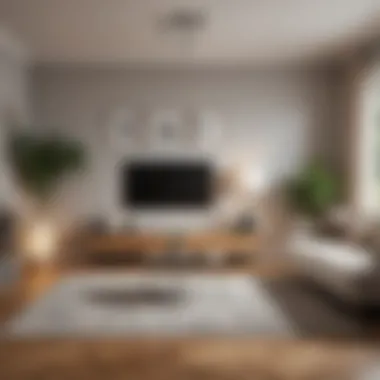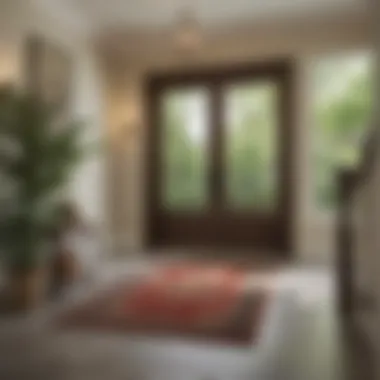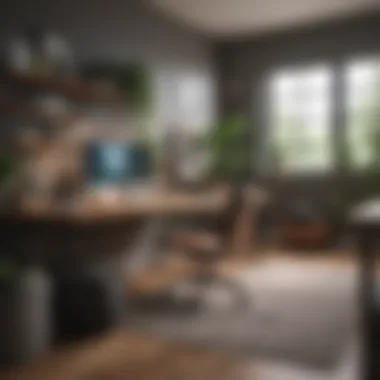Affordable Extensions: Enhance Your Home on a Budget


Intro
Home is more than just a place; it is an extension of identity and lifestyle. Increasingly, homeowners and renters seek affordable modifications that both enhance functionality and improve aesthetics without incurring high costs. With the right strategies, anyone can achieve meaningful changes in their living spaces, achieving a greater sense of satisfaction and comfort.
This article investigates a range of cost-effective methods for enhancing residential properties. Whether it’s through interior upgrades or exterior modifications, each idea taps into the desire for smarter living environments that don’t require a heavy financial outlay. This exploration aims to provide practical options capable of fitting various budgets, ensuring that every reader finds something relevant.
Key Insights and Trends
Current trends in interior design
The interior design landscape is undergoing a transformation, driven by the desire for sustainability and functionality. Homeowners are gravitating towards multi-purpose furniture, which allows for maximized use of limited space. Items like sofa beds or extendable dining tables can fit diverse needs without significant investment.
Another prevalent trend is the incorporation of natural elements. Designers are now leveraging eco-friendly materials that enhance living spaces while showcasing personal style. Using paint with low VOCs or reclaimed wood can elevate a room's character sustainably.
Popular gardening techniques of the season
Gardening, too, has seen significant shifts in recent times. Urban gardening has captured homeowners' attention. The focus on creating compact, efficient gardens that use vertical space or container gardening is noteworthy. Small herb gardens on balconies or indoor plants are becoming popular for those short on space.
Furthermore, many turn to permaculture techniques. This holistic approach to gardening promotes sustainable practices, focusing on maximizing yield while minimizing effort and expense. Homeowners can create productive landscapes using organic methods, such as composting or natural pest control, without needing vast resources.
Practical Tips and How-To Guides
Step-by-step guides for home decoration projects
- Define Your Style: Identify your design preferences by looking through magazines or online platforms.
- Create a Budget: Establish how much you are willing to spend on your next project.
- Choose a Focal Point: Decide on one key element, such as a bold piece of art or a statement couch.
- Shop Smart: Look for deals at local thrift stores or online marketplaces to find affordable pieces.
- DIY Where Possible: Consider simple projects like repainting furniture or creating wall art.
- Accessorize: Use cushions, throws, and indoor plants to tie the room together without a large investment.
Entertaining tips and planning checklists
Planning a gathering at home can also be achieved economically. Consider the following checklist:
- Set a Theme: Choose a simple theme based on the occasion.
- Create an Inviting Ambiance: Use string lights and candles to elevate the atmosphere.
- Plan Your Menu: Opt for budget-friendly dishes, possibly a potluck where guests bring their favorite and share.
- Games and Activities: Keep entertainment simple, relying on board games or trivia to engage guests.
- Post-Event Clean Up: Have trash bags ready to make the clean-up process easy and efficient.
"Affordability does not mean compromising quality; it means being resourceful with what you have."
Understanding Cheap Additions
When considering home improvements, it is vital to understand the concept of cheap additions. This section emphasizes the significance of incorporating cost-effective enhancements that increase the livability of your home without imposing a heavy financial burden.
Cost-effective additions offer an array of benefits. They can improve functionality and aesthetic without extensive renovation expenses. Recognizing the importance of cheap additions allows homeowners to explore options that align with their budgets, making home improvement projects realistic for more individuals.
By focusing on these modifications, you can gain insights into how to effectively utilize your available resources. It fosters creativity and encourages finding unique solutions that not only fulfill your immediate needs but also enhance the property’s overall value. Now, let us delve deeper into defining what these cost-effective additions look like.
Defining Cost-Effective Additions
Cost-effective additions refer to enhancements that achieve maximum impact for a minimal financial outlay. This includes alterations that do not require extensive labor or expensive materials but yield significant benefits. Some typical examples are simple cosmetic upgrades, practical interior modifications, and budget-focused outdoor improvements.
Homeowners might consider adding built-in shelves for better storage or utilizing wallpaper to enhance wall appearance. These solutions are typically inexpensive yet can fundamentally change the overall ambiance of a space. Creative repurposing of items can also fall under this umbrella, offering another layer of affordability while maintaining a fresh look.
Evaluating Your Budget
Evaluating your budget is a foundational step in planning any home improvement project. Understanding the financial constraints helps in determining what additions are feasible. Begin by assessing your current financial situation and identifying how much you're willing to invest in these modifications.
- Prioritize Needs vs. Wants: List what aspects are essential for your living space versus what could be classified as optional upgrades. This strategy clarifies spending priorities.
- Research Costs: Explore the estimated costs for materials and labor in your area. Websites like en.wikipedia.org and reddit.com can provide insights and discussions that inform your budgeting.
- Consider DIY Options: Implementing do-it-yourself strategies can significantly lower expenses. Resources from platforms such as facebook.com can connect you with communities offering advice on home projects.
Keep in mind that a well-planned budget does not restrict creativity; instead, it guides the most effective use of financial resources for home enhancements.
Interior Modifications
Interior modifications are crucial for enhancing the functionality and aesthetic appeal of your home. They allow homeowners to adapt their living spaces to better suit their needs without excessive financial investments. By focusing on cost-effective solutions, individuals can maximize their spaces while enjoying the benefits of improved organization and style. These modifications can transform not just the appearance, but also the atmosphere of a home, making it more inviting and practical.
Creating More Space Through Layout Changes
Removing Non-Load Bearing Walls


Removing non-load bearing walls can significantly open up a space and create a more fluid living area. This aspect is particularly relevant for homeowners looking to achieve a more spacious environment without extensive renovations. A key characteristic of this practice is its ability to increase the perception of space, which directly contributes to an enhanced living experience.
Removing walls is a beneficial choice because it can be done with relative ease and often at a lower cost compared to structural changes. The unique feature of this modification is that it allows for flexibility in design, offering options for new layouts that encourage interaction and comfort. However, it is essential to ensure that the walls being removed are non-load bearing, as taking down the wrong wall can lead to structural issues.
Optimal Furniture Arrangement
Optimal furniture arrangement plays a significant role in making a space feel larger and more organized. By strategically placing furniture, homeowners can create designated areas that are both functional and visually appealing. This practice is popular as it doesn’t require any major changes to the home structure and can typically be executed without any expense.
The key characteristic of this approach is its transformative effect on flow and accessibility within a room. The unique feature of optimal furniture arrangement is the immediate visual impact it can have; a well-arranged room can seem much larger and welcoming. However, care must be taken to avoid overcrowding, which can counteract the benefits of organized space.
Affordable Storage Solutions
Utilizing Vertical Space
Utilizing vertical space is a practical strategy in interior design that helps increase storage without consuming floor area. This method is particularly valuable in smaller homes where space is often limited. Its key characteristic lies in its ability to provide additional storage by installing shelves, hooks, or cabinets up high, thereby keeping the floor clear.
This choice is beneficial as it encourages organization and decluttering, essential for maintaining a serene living environment. The unique feature of utilizing vertical space is its versatility; it can be adapted to fit various needs, whether for books, kitchen items, or decorative pieces. One potential disadvantage is the need for stability and safety, especially in homes with small children.
Repurposing Old Furniture
Repurposing old furniture involves finding new uses for items that may no longer serve their original purpose. This approach not only saves money but also contributes to sustainability by reducing waste. A key characteristic of this practice is its creativity; homeowners can craft unique solutions tailored to their individual styles and needs.
Repurposing old furniture is a beneficial choice because it encourages personal expression and innovation in design. The unique feature here is the potential for a one-of-a-kind look, as each piece can be customized. However, the challenge lies in executing the redesign effectively and ensuring that the furniture remains functional after repurposing.
Enhancing Aesthetics with Paint
Choosing the Right Colors
Choosing the right colors can completely alter the mood and visual perception of a space. This aspect is crucial as color impacts both aesthetic appeal and emotional response. Its key characteristic is the psychological effect different colors can have, influencing feelings like calmness or energy.
Selecting appropriate colors is beneficial, especially in renovations, as paint is relatively inexpensive and easily changed. The unique feature of this choice is the wide range of options available, allowing for versatile applications in any room. However, it is important to consider how colors interact with natural light and existing decor to achieve the desired effect.
Techniques for a Professional Finish
Techniques for achieving a professional finish in painting not only ensure a polished look but also extend the life of the paint job. This aspect is significant as it addresses both aesthetics and functionality. A key characteristic of employing such techniques is the improvement in quality, often leading to fewer touch-ups and longer-lasting results.
Using professional techniques for painting is beneficial because it can prevent drips and uneven application, creating an attractive and durable surface. The unique feature is the investment in skills or resources to learn or execute these techniques effectively. The downside may include initial time and effort required to master these methods.
Incorporating New Lighting Fixtures
Selecting Energy-Efficient Bulbs
Selecting energy-efficient bulbs plays an important role in keeping energy costs down while also enhancing lighting quality. This aspect is crucial, especially for those looking to maintain their budget without sacrificing style or functionality. A key characteristic of energy-efficient bulbs is their longevity and reduced energy consumption.
This choice is beneficial as it contributes to sustainable practices in the home. The unique feature of energy-efficient bulbs is their availability in various styles, allowing homeowners to easily match their lighting to their decor. However, some might find the initial investment in these bulbs to be higher than traditional options, even if they save money in the long run.
DIY Installation Tips
DIY installation tips empower homeowners to take control of their lighting projects without needing to hire a specialist. This aspect significantly contributes to both cost savings and personal satisfaction in home improvements. A key characteristic of DIY tips is their adaptability for various skill levels, making them accessible to almost anyone.
Utilizing DIY installation is beneficial as it encourages learning and personal involvement in home modifications. The unique feature of this practice is the community support and resources available for guidance. However, there is always a risk of misimplementation, which can lead to safety concerns, especially with electrical work.
Flooring Options on a Budget
Vinyl Planks
Vinyl planks are a practical and stylish flooring option that can greatly enhance interior spaces. This aspect is significant as it provides a cost-effective alternative to hardwood without compromising appearance. A key characteristic of vinyl planks is their durability and ease of maintenance, making them ideal for busy households.
This choice is beneficial due to its water resistance and variety of designs. The unique feature of vinyl planks is their ability to mimic more expensive materials, offering a high-end look without the high-end price tag. The downside can include potential concerns over longevity compared to traditional flooring options.
Laminate Alternatives
Laminate flooring serves as another budget-friendly option, offering a wide range of styles to choose from. This aspect is important as it meets aesthetic goals while remaining within budget. A key characteristic of laminate is its relatively easy installation, making it suitable for DIY projects.


Opting for laminate is beneficial due to its affordability and durability, which can withstand wear and tear in high-traffic areas. The unique feature of this flooring is its resistance to scratches and fading, extending its usability. A potential disadvantage is its susceptibility to moisture damage, making it less suitable for very wet areas.
Exterior Modifications
Exterior modifications play a crucial role in enhancing both the aesthetics and functionality of your home. By focusing on the outside, homeowners can create an appealing environment that not only improves personal satisfaction but also increases property value. Affordable modifications can make substantial differences without significant expenditures. Understanding various options for exterior updates allows homeowners to choose improvements that align with their budgetary constraints while achieving the desired impact.
Curb Appeal Enhancements
Enhancing the curb appeal of a home can effectively improve its overall perception. When visitors approach a house and are greeted by a neat and inviting exterior, it sets a positive tone.
Landscaping on a Budget
Landscaping on a budget can completely transform the first impression a home makes. It involves using cost-effective plants, materials, and methods to create an appealing outdoor space. A key characteristic of this approach is that it maximizes the visual impact without the high costs typically associated with professional landscaping services. Popular choices include:
- Native Plants: Using native plants reduces water usage and maintenance efforts.
- Rock Gardens: Incorporating rocks and gravel can be both aesthetically pleasing and low-maintenance.
The unique feature of budget landscaping is its adaptability. Homeowners can gradually invest in their gardens, allowing for phased improvements. However, while this approach is generally advantageous, careful planning is necessary to avoid the appearance of neglect or haphazard growth later on.
Painting the Front Door
The front door serves as the gateway to a home, making its appearance vital. A new coat of paint on the front door is a small yet impactful update. This choice allows for personal expression while enhancing the home's exterior. A key characteristic is its simplicity. It requires minimal investment yet delivers immediate visual satisfaction.
In this context, unique features may include wide color options that reflect personal style or neighborhood trends. However, the disadvantage lies in the maintenance; the door may need repainting every few years to keep its fresh look.
Affordable Deck and Patio Options
Outdoor spaces provide a venue for relaxation and entertainment, making affordable deck and patio options valuable. These modifications create areas for social gatherings and personal leisure.
Using Composite Materials
Using composite materials for decking is a durable and low-maintenance choice. It boasts a key characteristic of resilience against weather, infestations, and decay, making it a long-term investment. Additionally, it mimics the look of wood but requires far less upkeep. It is popular among homeowners seeking sustainable solutions with minimal labor input.
The unique feature of composite decking lies in its availability in various colors and textures to suit different aesthetics. It can be more expensive upfront than traditional wood but proves cost-efficient over time due to its longevity.
Building with Pallets
Building with pallets represents a creative and resourceful approach to constructing outdoor spaces. This method involves repurposing shipping pallets into furniture or decking, making it an economic choice. A critical characteristic of pallet construction is its accessibility; materials can often be sourced for free or at a low cost.
Unique features include the ability to customize overall designs easily. However, utilizing pallets can have disadvantages. They may require additional treatment for durability and safety, ensuring they are suitable for outdoor use.
Creating Outdoor Living Spaces
Crafting outdoor living spaces enhances the home’s versatility. These spaces facilitate activities ranging from social gatherings to quiet evenings in nature.
DIY Fire Pits
DIY fire pits offer warmth and ambiance for outdoor areas. A practical contribution to the overall goal is that fire pits can foster gatherings, making them a popular choice for homeowners inclined towards outdoor living. A key characteristic of a fire pit is its customizable nature; it can be built from materials that match the homeowner's style and budget.
The unique feature is the simplicity of accessible designs, ranging from stone arrangements to metal bowls. However, homeowners must be cautious about safety regulations and placement to avoid hazards.
Simple Garden Furniture
Incorporating simple garden furniture can significantly improve outdoor living areas. This involves selecting furniture that provides comfort and functionality without excessive cost. A beneficial choice, simple garden furniture can be lightweight, affordable, and easily rearranged.
Unique features often include weather-resistant materials that require minimal care. Despite this, one disadvantage is that budget options may not offer the same longevity and stability as more expensive choices.
Installing Functional Outdoor Features
Functional outdoor features serve practical purposes while enhancing overall beauty. They streamline outdoor usage and can minimize clutter around the home.
Sheds for Storage
Sheds for storage are a practical solution for organizing outdoor spaces. Their contribution lies in creating designated areas for gardening tools, outdoor equipment, and other items. A key characteristic of sheds is their adaptability, working in various styles and sizes to suit specific needs.


Unique features range from aesthetic appeal to functional designs benefiting functionality. However, potential disadvantages include ensuring they are installed correctly and meet local zoning laws.
Greenhouses for Gardening
Greenhouses for gardening offer a means to extend growing seasons, enabling more diverse plant cultivation. This addition contributes positively by allowing homeowners to engage with nature year-round. A key aspect is the controlled environment provided, promoting healthy plant growth.
Unique features involve portability and prefabricated kits available for DIY enthusiasts. Yet, disadvantages can arise in initial costs and maintenance. Consideration of placement and local weather conditions is essential to maximize their usefulness.
Planning and Execution
When considering budget-friendly additions to your home, the steps of planning and execution play a crucial role. This approach allows homeowners to make informed decisions that effectively balance personal needs and budgetary constraints. By emphasizing these aspects, one enhances the likelihood of successful outcomes. Clear planning helps in identifying priorities, setting achievable goals, and reduces the chance of overspending.
Determining Project Priorities
Before embarking on any home improvement project, it is essential to establish clear project priorities. This process involves evaluating what areas need attention the most—be it increased space, enhanced aesthetic, or improved functionality. Homeowners should consider how each addition aligns with their lifestyle needs and long-term objectives.
By determining priorities, one can direct resources to the most critical aspects of the project. This might include starting with interior modifications that directly enhance daily living, or focusing first on outdoor adjustments that elevate curb appeal. A structured approach, backed by a budget, can prevent the common pitfall of pursuing too many modifications at once.
Securing Necessary Permits
Navigating local building regulations is a necessary step in the planning phase. Securing necessary permits ensures compliance with safety and zoning laws. Depending on the scope of the project, permits can range from simple notifications to complex applications requiring detailed plans.
It is advisable to research local regulations early on. This proactive measure can save both time and potential fines later. Homeowners can usually find specific permit requirements on their municipality's official website, ensuring they stay informed.
Finding Affordable Labor and Resources
Networking with Local Contractors
A key element in executing modifications is finding affordable labor. Networking with local contractors plays a significant role in this process. Building relationships with professionals allows homeowners to gain insights into services offered at various price points.
One notable characteristic of this approach is its focus on local expertise. Local contractors often possess knowledge of regional requirements and materials, which can improve project efficiency. Additionally, they may provide advice and alternative solutions, often at competitive rates. On the downside, homeowners should conduct thorough background checks to ensure reliability and quality in workmanship.
Utilizing Community Resources
Another viable option is utilizing community resources. Many communities offer access to shared tools, workshops, and even materials at little or reduced cost. This route not only reduces expenses but also engages homeowners in a broader community network.
Such resources often empower individuals to take on projects themselves, fostering a sense of accomplishment. However, the availability of community resources can vary greatly by location, which may limit options in some areas. Homeowners need to inquire locally or check community bulletin boards for these opportunities.
Utilizing both local contractors and community resources can create significant savings, paving the way for successful home extensions without straining finances.
Evaluating the Impact
Evaluating the impact of any home extension or modification is crucial. This process ensures that the enhancements you make serve a purpose and contribute positively to your living space. It entails considering various factors, including resale value, personal satisfaction, and practicality.
Understanding the significance of these evaluations helps you make informed decisions. It take into account what value improvements add to your home and how they affect everyday life. Furthermore, a sound assessment helps in avoiding unnecessary expenditure on projects that do not yield tangible returns or benefits.
In essence, evaluating the impact is about aligning personal goals with financial realities. The consideration of both resale value and personal satisfaction aids in creating a balanced approach to home improvements.
Assessing Resale Value
When planning home extensions, one must regard the potential impact on resale value. Many homeowners consider extensions an investment aimed at increasing property worth. Real estate markets fluctuate; thus, understanding market trends in your area can guide you in maximizing this potential.
A few points to consider when assessing resale value include:
- Market Trends: Current demand for homes of similar value can influence perceived value after modification. Check resources like Wikipedia for recent real estate trends.
- Quality of Work: A well-executed extension with durable materials can significantly enhance the home's stature. Buyers are often willing to pay more for quality.
- Functionality: Extensions should serve practical purposes. A space that improves functionality often appeals more to prospective buyers.
By implementing these considerations, you can ensure that your efforts to expand or modify your home do not merely match today’s trends but offer lasting value in the future.
Personal Satisfaction and Usefulness
Beyond financial interests, personal satisfaction plays a substantial role in evaluating the impact of home extensions. It deals with the functional and emotional aspects of your living environment. A space that resonates with your needs and lifestyle contributes to overall well-being.
Evaluating personal satisfaction involves asking yourself pertinent questions:
- Does this extension serve my family's needs? If the answer is positive, you are likely to enjoy the benefits for years.
- Is there alignment with my aesthetic preference? A personal touch in design often transforms a house into a home.
- Will this change improve my daily routine? Practical projects often lead to enhanced convenience and improved living.
Balancing the emotional and practical elements of home improvements ultimately enhances overall satisfaction. Improved utility and tailored aesthetics lead to spaces that feel more personal and functional.
"The value of a home is not just in its market price. Often, it's also about how these changes make your daily life better."
Through careful evaluation, you will find that home extensions can produce an enhanced living experience. They cater not only to market considerations but also to personal enjoyment.



